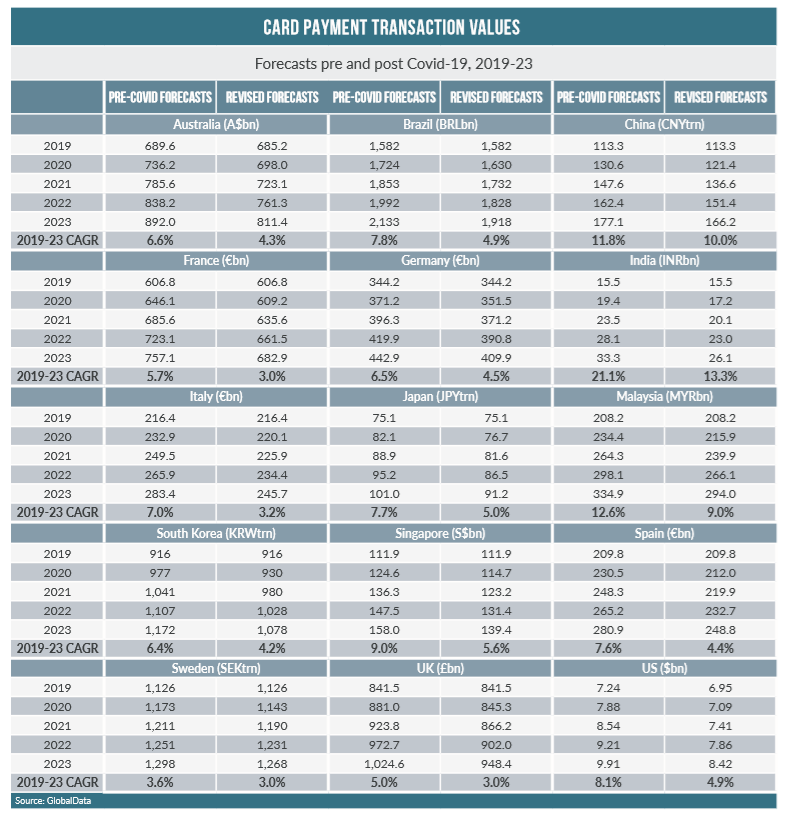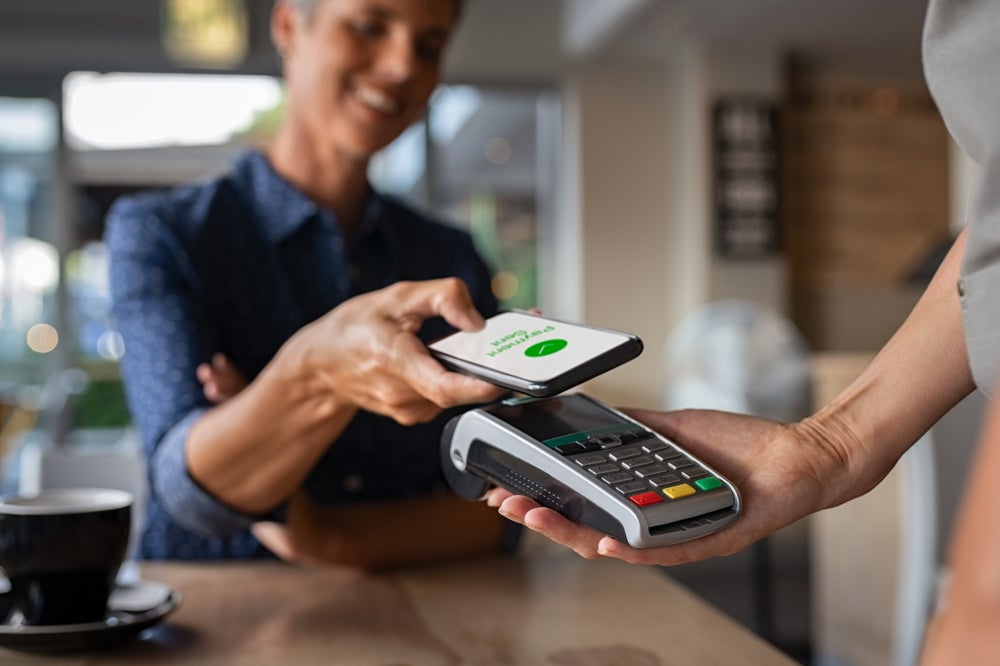
The rising demand for non-cash payments will drive card payments at point of sale but around the world there are interesting regional variations as a result of Covid, reports Douglas Blakey
While there will be a rise in debit and credit card transactions at the expense of cash, growth will be hampered by an overall decline in consumer spending due to Covid. To reflect this, CI has revised its forecasts for payment card transaction value and volume for the next four years, anticipating a reduction in projected growth for 2020. This will ultimately recover – but not to previously forecast levels.
The rising demand for non-cash payments is expected to drive card payments at point of sale (POS) terminals and will result in a decline in ATM cash withdrawals. This is particularly so in Australia with the number of card payments now forecast to grow by 3.6% in 2020. At the same time, there will be an 8.9% decline in ATM cash withdrawals.
The growth in card payments will also be driven by rise in contactless payments. Australia is one of the most developed contactless card markets with majority of the consumers using contactless cards. To encourage the shift away from cash, the contactless card payment limit is increased from A$100 ($70.30) to A$200 effective from April 2020.
GlobalData now expects Australian ecommerce market to grow at an annual rate of 17.4% in 2020, compared to estimated growth of 10.2% if the Covid pandemic had not occurred.
In the US, the number of card payments will grow by 1.7% in 2020; at the same time there will be a 4.3% decline in ATM cash withdrawals.
How well do you really know your competitors?
Access the most comprehensive Company Profiles on the market, powered by GlobalData. Save hours of research. Gain competitive edge.

Thank you!
Your download email will arrive shortly
Not ready to buy yet? Download a free sample
We are confident about the unique quality of our Company Profiles. However, we want you to make the most beneficial decision for your business, so we offer a free sample that you can download by submitting the below form
By GlobalDataThe prepaid card market in the US benefits from the US government sending out around four million American taxpayers their $1,200 stimulus using Visa prepaid cards. The handouts are in addition to the 150 million remittances already sent out by the tax agency as part of the economic impact payments.
Covid to boost low US, Brazil contactless usage
While the uptake of contactless card payments in the US remains relatively slow overall, this crisis ought to give also a push to these payments, since they also allow consumers to avoid touching cash or PIN pads. The crisis has also accelerated digital banking and payments transformation in the US.
According to a FIS survey published on in May, the Covid-19 crisis has rapidly altered consumer banking and payments behaviour in the US. Nearly 16% of the respondents say they have significantly reduced the use of paper money, while 31% said they will use contactless payments or mobile wallets instead of cash and cheques. Furthermore, nearly 40% will prefer to shop online in the future rather than in-store.
Brazil is another market with slow contactless growth pre-Covid but according to Mastercard, contactless payment volume in Brazil was four times higher in March 2020 compared to March 2019.
The use of online payment links has also increased since the onset of the pandemic. Domestic card scheme operator Cielo record a sevenfold increase in the use of payment links during quarantine compared to the pre-isolation period.
Brazil launches national QR code
The solution allows consumers to pay for their purchases via a link sent by the merchant. Many online retailers such as O Boticário, Ri Happy Brinquedos, and Santa Lolla are also favouring this payment method. During the pandemic, the country is advancing its payments industry.
In March, the central bank launched the national QR code standard BR Code, in order to enable interoperability of QR code payments. The adoption of BR Code will be mandatory for all payment service providers in the country from September 2020.
As per our revised forecasts, the number of card payments in Brazil will grow by 2.9% in 2020, while ATM cash withdrawals will increase by a meagre 0.1%.
By complete contrast, revised figures for China are off the scale by comparison.
China: 2020 e-commerce growth forecast to hit 22.3%
GlobalData now expects the Chinese e-commerce market to grow at an annual rate of 22.3% in 2020 compared to a previous estimate of 17.3%.
The number of card payments is now forecast to grow by 11.8% in 2020 with a sharp 15.6% decline in ATM cash withdrawals. While Chinese consumers have been hesitant about spending on big-ticket items. Alibaba’s sales grew by 22% in the three months to March 31, mainly driven by demand for groceries and electronics.
In Japan, companies such as Rakuten, Amazon, and Yahoo Shopping have seen their monthly online sales increase since the outbreak of the pandemic. Collectively, the year-on-year sales of these three e-commerce retailers registered an increase of 107% in January, 113% in February, and 114% in March. Card companies as well as online payment solutions including Konbini, Amazon Pay, and PayPal will benefit from this scenario.
In Japan, CI now forecasts that the number of card payments will grow by 2.6% in 2020 with a 5.5% decline in ATM cash withdrawals.
Malaysia: CIMB, Maybank release new card products
The growing preference for digital shopping results in leading Malaysian card issuers launching new products amid the Covid crisis. For example, in June CIMB Bank launched the Visa-branded e Credit Card. The standout feature of this card is bonus points for online spending, as well as spending at strategic partners, auto-billing payments, and in-store contactless payments.
Also, in June, Maybank rolled out a co-branded credit card in partnership with online retailer Shopee. The bank expects to issue 40,000 Visa Platinum Shopee credit cards within one year.
GlobalData’s 2019 Banking and Payments Survey found that 56.5% of consumers in Malaysia currently use mobile wallets, and this will likely increase strongly given the current situation. Apart from mobile wallets, Malaysians are increasingly opting for contactless cards. According to a Mastercard Impact Study conducted in April 2020, 24% of consumers in Malaysia stated they were using contactless payments more.
As per CI’s revised forecasts, the number of card payments in Malaysia will grow by 8.5% in 2020 while ATM cash withdrawals will rise by just 0.8%.
At the same time in Singapore, we forecast that the number of card payments will grow by 4.2% in 2020, with a 5.1% decline in ATM cash withdrawals.
Singapore is one of the most highly developed contactless card markets in the world, with the majority of consumers already having access to a contactless payment card.
Singapore: ‘Carry on with PayNow’
Citing the pandemic as an opportunity, the MAS and the Association of Banks in Singapore launched a campaign called “Carry on with PayNow” to promote the PayNow P2P and person-to-business digital instant payments service.
As a part of the campaign, all individuals using PayNow to make payments to businesses were eligible to win a cash prize in weekly draws from April 13 to June 21, 2020. Similarly, cash rewards were offered to businesses that signed up for PayNow and received payments from 9 April to 31 July 2020.
By contrast to the fumbling efforts of governments such as the US and Brazil to defeat Covid, the South Korean government has controlled the pandemic well thanks to robust measures.
A gradual recovery in the local economy and a rise in consumer spending will be seen going forward.
But even In South Korea, the pandemic will leave its mark on the cards sector. As per CI’s revised forecasts, the number of card payments will grow by 3.8% in 2020 with a 7.3% decline in ATM cash withdrawals.
The use of mobile phones for purchases of essential commodities will become even more widespread in South Korea, driving a rise in the use of mobile wallets such as Samsung Pay, Naver Pay, KakaoPay, and Zero Pay will rise faster than expected.
As CI goes to print, India now has the third-highest COVID-19 cases in the world behind the US and Brazil.
India: double digit drop in 2020 ATM cash withdrawals
With consumers switching from in-store to online purchases in order to avoid exposing themselves to disease vectors such as cash and point-of-sale (POS) terminals, there has been a rise in online purchases. Leading e-commerce retailers Flipkart, Amazon, Bigbasket, and Grofers have seen a 20–30% increase in orders each month since the outbreak of the virus. Popular online payment tools such as Paytm, PayPal, Amazon Pay, Visa Checkout, and Masterpass – as well as online processors and gateways – will benefit from this trend.
In India, CI now forecasts that the number of card payments will grow by 5.5% in 2020, with a subsequent 11.7% decline in ATM cash withdrawals.
To offer secure payment transactions, the Reserve Bank of India gave permission to Visa, Mastercard, and the National Payments Corporation of India – operator of the RuPay card scheme – on 1 May to enable contactless card payments at all retail stores.
After due upgrades by banks and payment service providers, consumers can make contactless payments in excess of INR2,000 ($28.05) without the need for a PIN.
Europe: Germany and Sweden in a league of their own
With a relatively modest death toll of 9,000 Covid deaths by early August, Germany is the one major European country to have tackled the virus effectively. Such a death toll equates to a 110 deaths per 1 million residents.
In the other major European markets, the corresponding figures are sobering. Spain reports 29,000 deaths (612 deaths per 1 million) just ahead of the UK with 42,000 deaths for 609 per 1 million. Italy and France with 36,000 and 31,000 deaths respectively results in 586 and 507 deaths per 1 million residents.
Germany does not escape revised forecasts for the card sector post-Covid but the revisions are modest. CI now forecasts the number of German card payments will grow by 3.3% in 2020 with a 2.9% decline in ATM cash withdrawals.
According to the German Credit Agency, over half of card payments made are now contactless, compared to 35% before the pandemic.
To encourage the shift away from cash, contactless payment limits across several European countries (including Germany) have been raised. The new limit in Germany is €50 ($56.14), up from €25.
In Spain, cash has traditionally been a popular payment instrument, accounting for over 60% of total transaction volume. But according to a study carried out by digital-only bank N26, cash withdrawals in Spain fell by 68% in March 2020.
As per our revised forecasts, the number of card payments in Spain will grow by 2.3% in 200 with ATM cash withdrawals set to drop by 4.4%.
To promote online sales, CaixaBank launched Social Commerce, a new online solution enabling merchants to sell their products on social networks including Facebook, Twitter, Instagram, WhatsApp, and Telegram.
Covid crisis boosts prepaid in Spain, Italy
The pandemic is also pushing the use of prepaid cards. For example, CaixaBank extended its partnership with the government to distribute 200,000 social welfare prepaid cards aimed at recipients who are struggling to access their benefits due to the current situation.
In Italy, the pandemic has had a severe impact on the country’s tourism sector, which accounts for around 13% of GDP. According to the Italian tourism association Assoturismo Confesercenti, €200m worth of travel and accommodation bookings were cancelled in March alone. Key tourist destinations such as Rome and Sicily registered travel booking cancellations of as high as 90%.
Cash has historically been the preferred method of payments in Italy and is at the heart of the Italian economy, accounting for 78.5% of total payment transaction volume in 2019. But this is changing due to the outbreak.
The Italian prepaid card market will benefit due to the pandemic, as the Municipality of Milan selected Mastercard branded Soldo’s prepaid card to distribute emergency aid to vulnerable citizens.
Milan was the first authority to adopt Soldo Care, and uses the cards to help distribute its portion of the Italian government’s €400m solidarity fund. A further 21 Italian authorities have signed up to use the cards to distribute emergency aid in their regions.
As per CI’s revised forecasts the number of card payments in Italy will grow by 2.2% in 2020, compared to a drop of 3.6% in ATM cash withdrawals.
As in Italy, France is being hammered as a result of a major loss of travel and tourism revenue. According to Jean-Baptiste Lemoyne, the secretary of state for tourism, the French travel and tourism industry is estimated to have lost around €10bn in the first four months of 2020. Paris alone has witnessed a 70% drop in hotel bookings and a loss of 30% in revenue since the beginning of the crisis.
According to GlobalData’s revised forecasts, the number of card payments in France will grow by 1.6% in 2020, with a simultaneous decline of 6.3% in ATM cash withdrawals.
An even sharper drop in ATM withdrawals is forecast in the UK. The equivalent UK figures are for card payments to grow by 1.7% in 2020, with a decline of 7.7% in ATM cash withdrawals.
Sweden: unique approach to pandemic
Sweden’s softer lockdown approach and other government measures were able to reduce the pandemic’s impact, resulting in an anticipated gradual recovery in the second half of 2020. The revival in economy will benefit the payments industry as well.
With over 5,500 deaths by early August and a mortality rate from Covid of around 550 deaths per 1 million residents, Sweden has fared no worse than Spain, Italy and the UK with their more severe lockdown measures.
The counter argument of course will be the modest mortality rate in neighbouring Scandinavian countries. For example, Denmark has suffered only around 100 deaths per 1 million of population.
Sweden leads the global race to becoming a ‘cashless’ society, with cash accounting for just 1.1% of the country’s overall payment transaction value in 2019. The current situation is expected to further accelerate the shift as consumers avoid cash as a potential disease vector.
The pandemic is also seen to push the adoption of digital payments among Swedish merchants. Swish, a popular payment solution in Sweden, observed an increase in transactions at merchants by 33.3% and 93% in terms of volume and value respectively in March.
In order to discourage the use of credit for online transactions amid rising debt and the ongoing pandemic, the Swedish government amended its Swedish Payment Services Act. Effective from July 1, 2020, online merchants offering various payment options are required to present non-debt payment methods (such as Swish) on the list first.
Additionally, merchants are also prohibited from selecting invoice or instalment payment options by default during the online checkout process. This move is likely to affect the growth of buy-now-pay-later solutions operating in the country such as Klarna.
Contactless technology in Sweden is already well established and being given a further boost by the pandemic. According to Nets, 48% of the total card payments in the country were contactless at the beginning of April 2020, compared to 42% at the beginning of the year. Moreover, Visa and Mastercard have increased their contactless card payment limits from SEK200 ($21.41) to SEK400.
GlobalData now expects the Swedish ecommerce market to grow at an annual rate of 19.3% in 2020, compared to a previous estimate pre-Covid of 10.5%.









